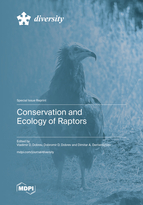Conservation and Ecology of Raptors
A special issue of Diversity (ISSN 1424-2818). This special issue belongs to the section "Animal Diversity".
Deadline for manuscript submissions: closed (30 April 2023) | Viewed by 21784
Special Issue Editors
Interests: conservation biology; raptor ecology; bird migration; scavengers; biodiversity
Special Issues, Collections and Topics in MDPI journals
Interests: raptors; scavengers; conservation ecology; behavioural ecology; spatial ecology; movement
Special Issues, Collections and Topics in MDPI journals
Interests: conservation biology; raptor ecology; bird migration; dietary research; niche overlapping; raptor ethology
Special Issues, Collections and Topics in MDPI journals
Special Issue Information
Dear Colleagues,
Raptors are a diverse avian guild distributed worldwide and adapted to different environments. They have attracted a strong interest from scientists because of their conservation status and ecology. Raptors provide critical ecosystem services based on their role in natural food chains. Raptors have evolved ecologically to adapt and specialize to different habitats and prey species. Thus, they are subject to a wide range of biological, ecological and evolutionary studies. At present, this guild of birds faces a high risk of extinction due to numerous threats that occur in their breeding, migration and wintering areas. Globally, eighteen percent of raptors are threatened with extinction and 52% of raptors have declining populations. Raptors stand at the top of food pyramids and normally occur at low densities over vast areas. Some species are long-distance migrants while others are sedentary. Hence, they cover a huge range of habitats and environments and interact with humans during their migration, wintering and breeding. Therefore, they play a keystone role in the conservation of ecosystems and are assumed as flagship species in relation to other species. Understanding and studying their demography, abundance, diet, resource selection, movements, ecological requirements and threats will provide valuable information about current ecosystem functioning and status.
This Special Issue will provide information regarding the current state of raptors across the world and their role in global conservation priorities.
Dr. Vladimir D. Dobrev
Dr. Dobromir D. Dobrev
Dr. Dimitar A. Demerdzhiev
Guest Editors
Manuscript Submission Information
Manuscripts should be submitted online at www.mdpi.com by registering and logging in to this website. Once you are registered, click here to go to the submission form. Manuscripts can be submitted until the deadline. All submissions that pass pre-check are peer-reviewed. Accepted papers will be published continuously in the journal (as soon as accepted) and will be listed together on the special issue website. Research articles, review articles as well as short communications are invited. For planned papers, a title and short abstract (about 100 words) can be sent to the Editorial Office for announcement on this website.
Submitted manuscripts should not have been published previously, nor be under consideration for publication elsewhere (except conference proceedings papers). All manuscripts are thoroughly refereed through a single-blind peer-review process. A guide for authors and other relevant information for submission of manuscripts is available on the Instructions for Authors page. Diversity is an international peer-reviewed open access monthly journal published by MDPI.
Please visit the Instructions for Authors page before submitting a manuscript. The Article Processing Charge (APC) for publication in this open access journal is 2600 CHF (Swiss Francs). Submitted papers should be well formatted and use good English. Authors may use MDPI's English editing service prior to publication or during author revisions.
Keywords
- raptor ecology
- migration ecology
- demography
- population dynamics
- habitat
- threats and conservation management
- diet
- home range








